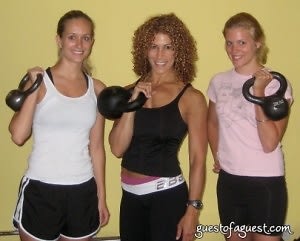When Rachelle and I first met Lorna Kleidman in the lobby of Core Dynamics, the same thoughts crossed both of our minds: a) this woman is a lean, mean, fighting machine, and b) how? The answer lies in a little metal ball with a trapazoid-shaped handle, and the determination of one asthmatic boxing burn-out to wield it. Somewhere between Lorna's physical appearance, her friendly, yet empassioned demeanor, and the fact that, in just three years, she went from greenhorn to International Master of Sport and National Champion, she sold us. Below, Lorna talks Spetznaz, Ferraris, and why you'll never need to run again...
When we first watched you, we were a little apprehensive. The way the exercises are performed, with all that momentum... it looks like they could hurt you! Like any skill (golf, swimming), if you don’t learn proper technique, you could potentially get injured. But the reality is that once you learn the fundamental drills, the swing, for example, you have a full-body movement that is efficient, effective and less injurious than most other modalities. That’s why the Russians made kettlebells the only tool to keep their populous fit- it kept farmers, factory workers, laborers strong and productive, reducing health care costs. Weight machines and even dumbbells do not allow full range of motion to the joints; they limit the body’s ability to work synergistically, functionally. You’re going to be hearing and reading a lot about functional training if you haven’t already. Many new clients express concern that kettelbell training will hurt their troubled back. I explain that in order to control the bell’s momentum as it is moved, the body is constantly engaging the stabilizing muscles, or ‘core’. This stabilization is vital for those with a history of back problems, and with kettlebells, the stabilization is stimulated through natural movement, as opposed to sitting on a machine or focusing on one muscle group at a time. I continue to witness over and over the cessation of back issues once clients begin working with kettlebells. As for myself, I have a very rigorous workout regime and have not one injury. Why are they named Kettlebells? The name has a long and interesting history which began with the church, surprisingly! For centuries church bells were rung through the act of pulling levers which were strung through wheels and attached to the bells. Some bells weighed as much as three tons, requiring a team of qualified men possessing great strength, skill and coordination to affect the proper sound. In an effort to perfect the technique, bell-ringers would practice with non-clapper bells, called “dumb-bells”. Similarly, Scottish legend has it that would-be strongmen utilized old or leaky cast iron cooking kettles as rudimentary weights. By filling the kettles with sand, soil, or lead shot, they became load-adjustable strength-training tools which could be lifted, pulled or swung about. In time, the name “kettlebell” was coined. So what, exactly, is the origin of the kettlebell? Back in old Russia, kettlebells were used on market place scales as counter-weights. For fun, vendors would show off their strength prowess by pressing, swinging or tossing the weights about, and as the generations passed, these casual movements developed into skills which fathers taught to their sons. Kettlebells soon became a customary form of entertainment in Russian culture with lifting or juggling exhibitions being a regular feature at fairs, holiday times, and the circus. But the Russians took it further than that, they recognized the benefits kettlebells would provide the men and women who worked as laborers in their economy. In 1981 the first official Kettlebell Commission was formed with the sole mission of enforcing mandatory kettlebell exercise and conditioning for the populous. They understood that this singular instrument would keep its people fit, increase productivity, and decrease healthcare costs. Kettlebells became the conditioning tool of choice for the Russian Special Forces, the “Spetznaz”, creating soldiers who possessed incredible explosive power and endurance. Now many professional athletes use the bells in their training programs for the same results. The bells are ringing here now, but the following, though ardent, is pretty small. How did you come across it? In 2005 I moved to South Florida and it was there that I met my mentor. I trained with him 3 days a week for almost 2 years, before moving back to NYC. It has been my passion ever since. Kettlebells’ popularity is growing very quickly, yet there are many aspects about it that are mysterious and intimidating to those who have not yet tried them, or found a trainer who knows how to teach the skills. It is a different way of working out, and anything different takes a while to catch onto, even when it is better. It’s important for people to be reminded that kettlebell movements are skill-based and should be learned from an experienced, qualified instructor, just as one would learn golf or swimming. What can you expect to gain from training with kettlebells? In a nutshell- when you train with kettlebells you create a Ferrari engine to go along with your Ferrari-looking body. Even the most basic kettlebell movements engage every muscle group, from the superficial to the deep stabilizers. The result is increased metabolism which burns fat quickly, lean muscle, strength, speed, power, endurance, balance and coordination. AND, it is FUN! Do you need to do cardio or any supplemental exercise with kettlebells? When I tell my new clients that they can eliminate all those crunches and long runs after their weight training sessions, they look at me with bewilderment. The fact is that you don’t need to do any extra cardio in addition to the kettlebell training. That’s one of the reasons it’s so fantastic- it addresses every aspect of fitness: aerobic and anaerobic capacity, strength, endurance, speed, power, agility, balance, fat loss. Now, if you have a specific sport or goal that you’re training for, you will always make that the highlight of your regimen. But kettlebells enhance any and all activities. In fact, a study conducted in 1983 observed two groups of athletes over a period of several years and tested them with standard military tests: pull-ups, standing broad jump, 100m sprint, and 1k run. The control group followed a typical university physical education program that emphasized the specific aforementioned activities. The experimental group just lifted kettlebells. . In spite of the lack of specific training on the tested drills, the kettlebell group showed better scores in every one of them! You boxed before; did your body change once you started using kettlebells? I was involved in everything over the years- aerobics, step class, sculpt and more recently boxing conditioning, which is very challenging. I loved it, but after a couple of years I found I had reached a plateau, I wasn’t progressing further with my physical ability and the level I had attained was getting tough to maintain. Like many fitness enthusiasts, I would get terribly anxious if I thought I would miss a class because I was so afraid that I would lose strength or gain weight. As a result, I trained longer and harder, 6 days per week, taking private lessons hitting pads, running more outside, doing more pushup, etc .More, more, more…. I looked as if I was in good shape, but after a few months of training with kettlebells, my endurance and breathing capacity increased, my body looked even more toned with less work, and my power and speed went through the roof! Now I box once or twice per month, and I’m better than I ever was before using the kettlebells. When did you decide to start competing? Last year I went to San Diego to learn about competition-style kettlebell lifting. The instructor encouraged me to train to qualify for the International Championship which was 8 months away. He became my Coach and I earned the #1 ranking in the country. Describe the competitions; I know you had one in San Diego and an upcoming one in Italy. Kettlebell sport began in Russia and is a highly challenging strength endurance feat which combines flexibility, aerobic and anaerobic capacity and technique. As in most sports, refinement and efficiency of movement can take years to acquire. Competitors are given 10 minutes to perform as many repetitions of the determined lifts without putting the kettlebell down. And, you can only change hands one time in the 10 minutes. In December 2007 I earned the highest title achievable in the sport- International Master of Sport, as well as a Gold medal in my age category and Silver medal in my weight category by performing 193 consecutive lifts, called ‘snatch’, with the requisite 35 lb. Etalon kettlebell. There were 10 countries represented, with the best of the best present, including one man who is in his 70’s! He’s been competing for decades; it was so inspiring! I only wished I could speak Russian or Ukrainian so I could have communicated with them! What made you want to bring kettlebells to Core Dynamics in Water Mill? Do you love teaching as well as performing? I love the process of training for a goal. It is very intense and demanding, but of course very rewarding. Competing is pretty tough, I wouldn’t say that I love it, I just enjoy reaching the goals I’ve set. Through the years friends have suggested that I teach fitness in some capacity, but it never interested me until I really understood what the kettlebell was all about. Even then, I didn’t begin teaching until I had trained with them for 3 years. I am passionate about what I do and get excited when I plan each and every class. I happened to come into Core Dynamics soon after they opened and was immensely impressed to find the bells there! I returned this past winter and introduced myself to Jim, telling him of my experience and performance at the International Championship. He understands the value of kettlebell training and totally embrace the idea of offering small group classes. The challenge is finding trainers who are qualified to teach the skill. How long do you plan on using them? As long as I live, I’ve never looked, felt or performed better. Besides Core Dynamics, where can we take a class? I teach Kettelbell Academy at the JCC of Manhattan, 76th and Amsterdam Ave. Tuesday and Thursday mornings as a continuous 8-week series. Where do you like to refuel around here? I love Trata’s on Friday evening, great food and fun music. B. Smith’s and Babette’s are standard favorites. There's also Provisions juice bar, and Hampton Café across route 27 from Core Dynamics.
Lorna teaches outdoor Kettle Bell Academy classes at Core Dynamics every Saturday and Sunday morning at 9:30.



.jpg)
.jpg)



.jpg)
.jpg)
.jpg)




.jpg)